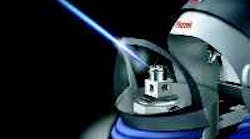Does Mazak hold the keys to the future of manufacturing?
Spindles on Mazak's Super Digital Machine of the future will run at 100,000 rpm and maintain an acceleration of 8 G.
Lasers will perform both laser hardening and part measurements on the 2019 model concept machine.
The Super Digital Machine along with digital technology will lead to worldwide digital manufacturing.
With a rapid traverse rate of 3,542 ipm and a 1.5-G acceleration, Mazak's FF-660 is an ultra high speed horizontal machining center for mass production applications.
Better machine design and improved manufacturing processes have been in Mazak's field of view for the last 80 years, and the company doesn't intend on letting them out of its sight. In fact, Mazak has a vision of a new machine tool that truly challenges the metalworking industry's status quo. In anticipation of its centennial celebration in 2019, Mazak Corp., based in Oguchi, Japan, has unveiled the conceptual design of its Super Digital Machine. If this conceptual design becomes a reality by the time Mazak hits its 100th anniversary, the company will certainly be credited for revolutionizing the world of manufacturing.
Super specs
The Super Digital Machine transforms multitasking into ultratasking. In one setup, it performs all turning, milling, I.D and O.D. grinding, and measuring operations. The machine employs dry cutting technologies and completes hardening processes with a laser. Finished parts are measured by another laser without ever having to leave the worktable.
This futuristic machine's spindle runs at 100,000 rpm. Its rotary table indexes in increments of 0.0001° and maintains a table speed of 8,000 rpm for turning operations.
In addition, a cutting feedrate of 500 m/min (1,640 ft/min) with 8-G spindle acceleration and Mach 2 cutting speed (40,000 m/min or 131,234 ft/min) will add a dimension to machining never before thought possible.
Although spindle speeds and cutting feedrates have increased throughout the years, attaining these figures by 2019 will be a daunting task. What may be closer around the corner, however, is the realization of complete digital manufacturing.
Command central
Remote diagnostic and servicing capabilities are cropping up among the larger machine tool companies in the industry and have proven their viability and worth. So the concept of a production control room may not be too far off the mark. According to Mazak, all of the Super Digital Machine's functions will be monitored and controlled in a production control room — a control tower of sorts — which possesses the capability of overseeing similar machines throughout the world. From here, technicians will be able to troubleshoot from afar, as well as initiate and complete full production runs.
The here and now
Only time will tell whether or not the Super Digital Machine will officially meet the metalworking industry in the year 2019. But Mazak has been working on advanced technologies that may eventually help lead to its introduction. For example, the company has been incorporating new technologies into its current machine tools for the aerospace, automotive, energy, die and mold, and general machining industries. The Integrex 70YB and the FF-660 are just two examples of Mazak's advanced machine tool technology.
The Integrex 70YB is a multi-tasking CNC lathe with a B-axis for machining inclined faces and inclined holes. Almost all parts can be machined in one setup.
The FF-660 ultra high speed horizontal machining center is designed for high production parts. Besides maintaining a rapid traverse rate of 3,545 ipm, the machine also delivers a feed acceleration of 1.5 G and a spindle startup time of 1.3 sec (0 to 15,000 rpm).
A 3PC cyber-production module is standard on the FF-660. One module consists of one machine tool and one robot. The 6-axis articulated robot transports the parts for machining from the workpiece loading conveyor to the pallet changer, and then to the workpiece turnover unit and the unloading conveyor, so users can obtain complete products just by setting material on the loading conveyor. By linking modules with Mazak's Production Center programming software, via a cyber network, an entire plant can run as a "cyberproduction" facility.
Other advanced technologies for spindle systems include three improvements: a new generation motor, magnetic bearings, and under-race, oil-air lubrication.
The new motor concept has a permanent magnet embedded in the rotor. This design makes the motor more compact, powerful, and efficient. Adoption of this type of motor to the spindle drive system of machine tools is currently being tested.
Magnetic bearings constitute the second improvement. Unlike ball bearings, magnetic bearings are completely free of abrasion and wear, resulting in quiet, low-vibration spindle operation over extended periods.
The third improvement involves lubrication. Under-race, oil-air lubrication technology suppresses heat generation of the bearings, which ultimately affects part accuracy.
Although it is too early to determine if these particular technologies will become a part of the Super Digital Machine, Mazak has proven its dedication to machine and process improvements. Undoubtedly, the company works to advance the industry by challenging the status quo.






